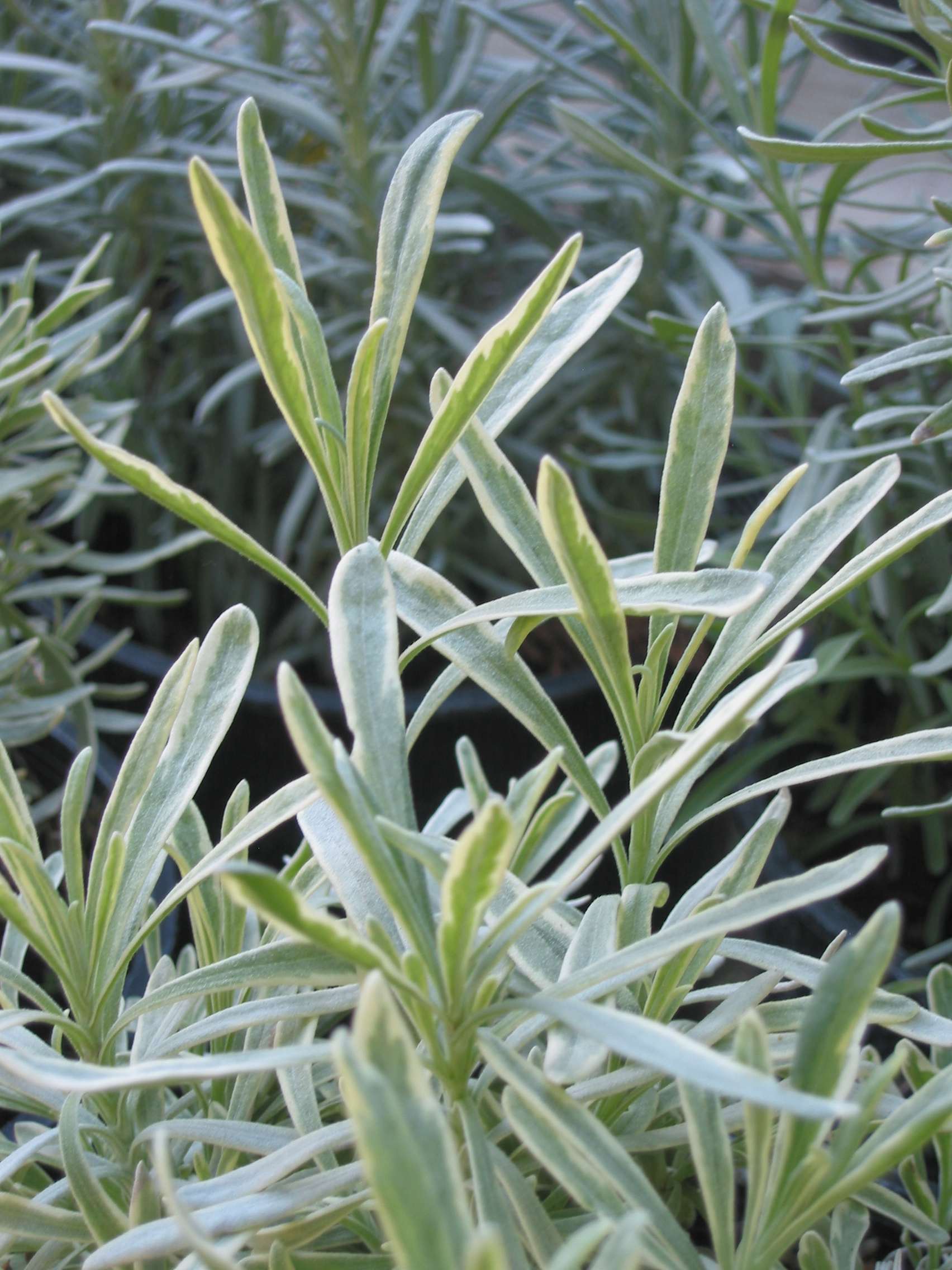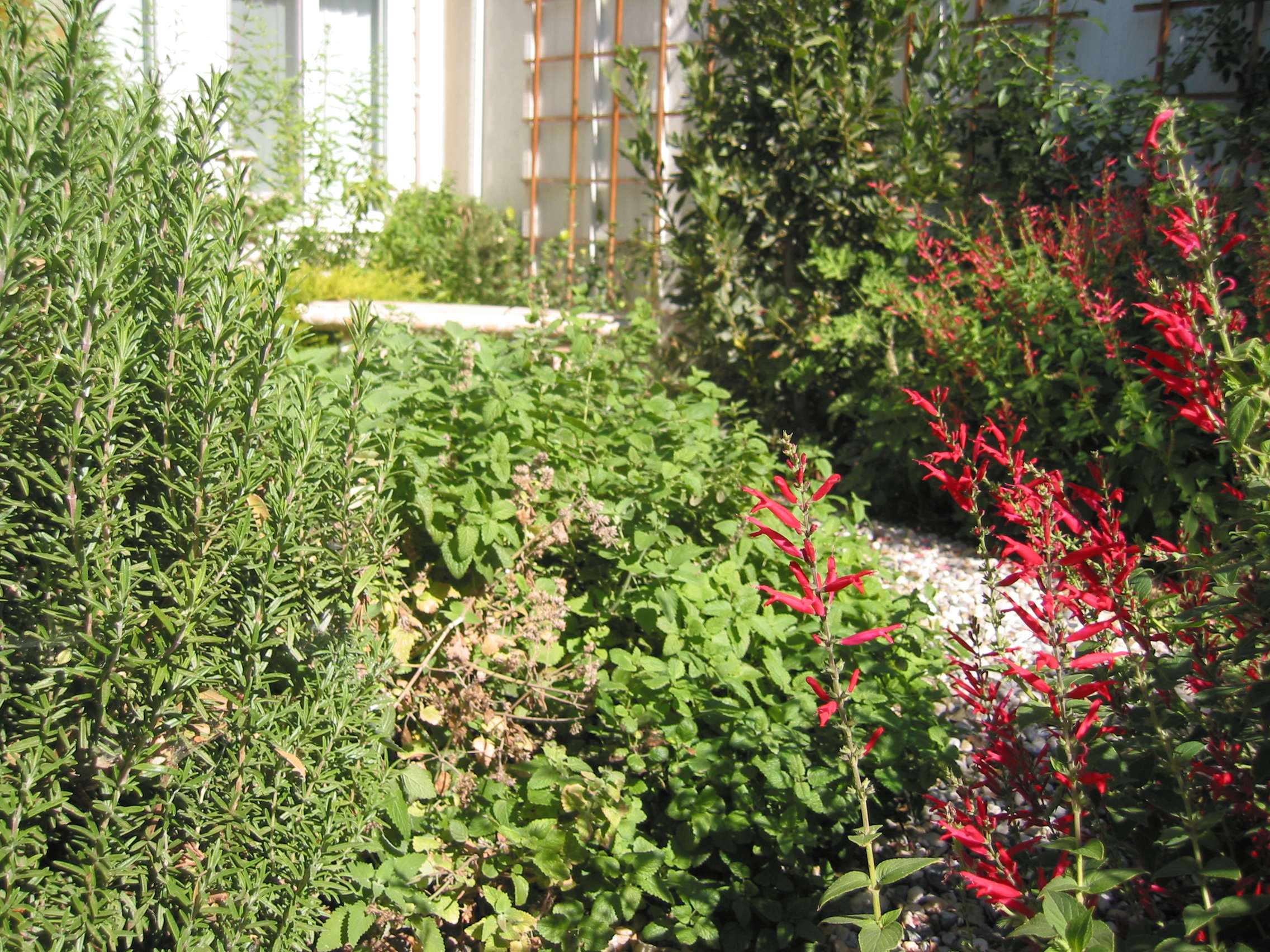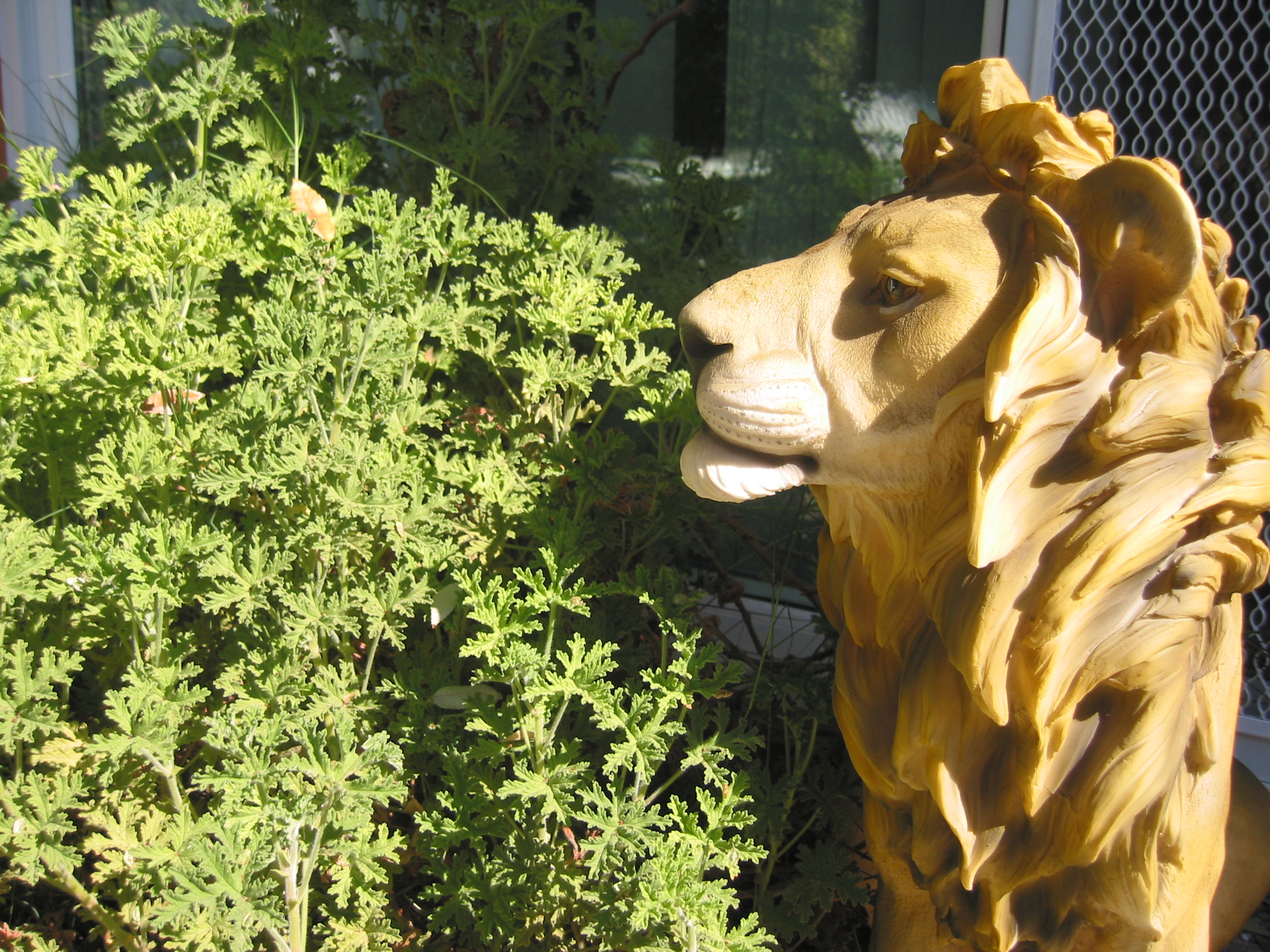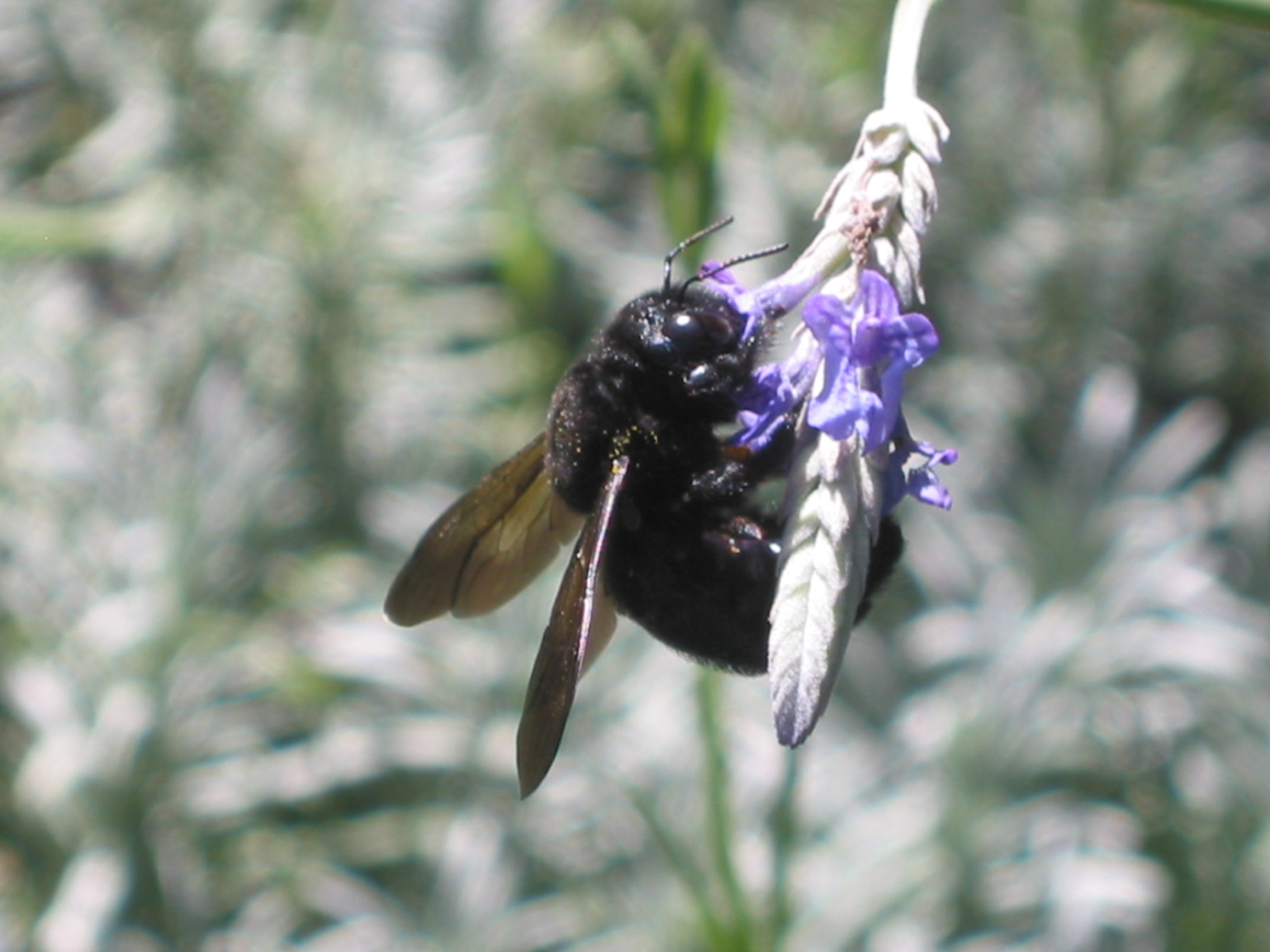Fragrant foliage
From the Davis Enterprise, October 23, 2008
A garden for the senses
Chris T. is a popular professor at UC Davis. He also is an avid gardener who happens to be blind. Never mind that he can't see the plants in his yard -- he can touch and smell them. Chris transformed his boring front landscape -- all lawn and rose bushes when he bought the house -- into a serene, drought-tolerant, and interesting garden full of plants with texture, fragrance, and character. And he graciously allowed me to photograph his garden for this article.
A garden of scented plants is best in a sunny location to increase the oil content of the leaves. A leisurely path with twists and turns will help you bruise the foliage as you meander, releasing the volatile compounds. The curved path slows down a visitor to admire a showy flower or interesting foliage. A bench is a must, and garden ornaments - statue, fountain, rocks, or windchimes - can be used to create a visual draw or an element of surprise.
 gravel path and bench
gravel path and bench
Use interesting leaf textures and colors. These gardens are intended to be touched, felt, smelled, and lingered in. Peppermint-scented geranium has a fuzzy leaf with a biting minty scent. When you brush against winter tarragon, a peppery, medicinal-smelling aroma is released. It's almost unpleasant, and certainly could be overdone, but is complementary to the other plants in small doses. Low creeping forms of thyme, and honey-scented sweet alyssum, can spill into the path to take light foot traffic.
It's important to have a few larger, backbone plants in the garden. Many of the herbs and perennials used here are dormant in winter or have low, trailing habits. So a few plants of year-round stature keep things from getting too untidy in the off-season. Bay tree (Laurus nobilis), lavenders, upright forms of rosemary, and kitchen sage look good all the time. Rosemary even blooms in winter.
What makes a plant fragrant?
Fragrance in a flower has a pretty obvious adaptive value to a plant: it draws pollinators to the flower, who carry the pollen off to other flowers. This reduces the amount of pollen a plant has to produce (earlier flowering plants were wind-pollinated); it increases seed production and increases the likelihood of cross-pollination - thereby expanding genetic mixing.
But what advantages do chemicals in leaves provide? And what are these chemicals, anyway?
Among the many carbon molecules plants produce are phenolic compounds, which perform a wide range of functions in the plant. The pigments of flowers are phenolic compounds, as are various bitter, astringent, and toxic chemicals plants produce. Juglone, excreted by walnut (Juglans) roots, stunts and kills many other plants that try to grow under walnut trees: a natural herbicide. Plants produce their own natural fungicides and pest repellents. Thymol, a natural antiseptic occurring in thyme, is one of the constituents of Listerine mouthwash. So while some of these chemicals enhance the plant's attractiveness to pollinators (and us!), others repel pests and diseases.
Geraniol is the main chemical in lemongrass oil and lavender oil, and is the major constituent of rose fragrance. Citronella, which is added to candles, Lemon Pledge, soaps, etc., is a related compound. These are also the major constituents of verbena oil, lemon and lime oils, ginger oil, and other plant essential oils; they are the main source of lemon odor, and are also used as flavorings. Geraniol affects insects: it is a pheromone of certain species of bees, being secreted by the scent glands of worker bees to signal the location of nectar-bearing flowers and the entrances to their hives.
As with grandmother's perfume, the dose makes the difference! Although they may be bitter in large quantities, we find some of these chemicals in leaves attractive and even palatable in small doses: pesto is made from basil, and peppermint and spearmint oils find their way into candy and tea. But to some insects they can be overwhelming and act as natural pesticides or repellents.
Plant leaves often contain specialized cells that release the volatile oils into the atmosphere under warm or humid conditions. If you walk by a curry plant (Helichrysum italicum) on a warm afternoon, you will quickly recognize where the name comes from: it isn't used in cooking, but it smells just like curry as the vapors drift off of the shrub. Similarly, brushing or bruising a leaf is enough to release the scent of lemon verbena or rosemary. Many of these chemicals aren't soluble in water, so to 'capture' them they must be soaked in alcohol or other solvents. Just rubbing a leaf keeps the scent on your fingers for hours, as the chemical doesn't wash off readily.
Plant suggestions
When Chris recently asked me for some plants to finish up his front garden, I came up with the following list. All of these plants prefer full sun, tolerate moderate drought, and are (not surprisingly) nearly pest-free.
- Agastache. Called anise hyssop for the spicy, licorice scent of the leaves, the flowers strongly attract hummingbirds. Older species were kind of rangy; new hybrids have more compact growth habit and more vivid colors.
- Aloysia triphylla. Lemon verbena. This is an elegant, informal shrub to 6' or more with powerfully lemon-scented leaves. Make it a focal point and thin in to enhance the open growth habit.
 Lemon verbena, left, in front of Coleonema 'Sunset Gold'
Lemon verbena, left, in front of Coleonema 'Sunset Gold'
- Lavendula 'Warburton Variegated'. Many lavenders, of course, have fragrant flowers, particularly the English lavenders and the hybrids called Lavandins. But a few have exceptionally fragrant foliage, including this one.
 Lavender 'Warburton Variegated'
Lavender 'Warburton Variegated'
- Mentha. Spearmint is the most commonly used in tea, peppermint in cooking and tea. All spread vigorously by runners, which can be kept in check by cutting every couple of months. Silver mint is one of my favorites, with soft grey-green leaves and an especially sweet fragrance.
- Rosemarinus officinalis. Rosemary. Tuscan Blue is one of the best, with a spicy pine scent and vivid blue flowers in winter.
- Salvia species and varieties. I often tout Sages for their garden beauty, attraction to hummingbirds, and overall toughness. Some also have exceptionally pungent foliage. Salvia elegans, the pineapple sage, is aptly named; variety 'Frieda Dixon' has showy flowers well into winter. The cooking sages, varieties of Salvia officinalis, are attractive shrubs year-around, including types with purple or variegated leaves.
 Pineapple sage 'Frieda Dixon', right
Pineapple sage 'Frieda Dixon', right
-
- Thymus species. Lemon thyme is one of my favorites, a compact little shrublet with golden-variegated foliage. Creeping thymes make great ground covers around step stones and among other shrubs.
Finally, scented geraniums belong in every fragrance garden, even though we risk losing them in a cold winter here. There are a couple of dozen varieties and species in the genus Pelargonium, with appropriately descriptive names: Apple, Apricot, Grape Leaf, Lemon, Lime, Orange; Rose, Attar of Roses, Chocolate Mint, Nutmeg, Peppermint! Some have tight, crinkly leaves, others are broad and fuzzy. The bigger ones can sprawl all over the place; Chris even tied up a Staghorn geranium (spicy mint scent) on his fence as a vine.
 Scented geranium
Scented geranium
A nice bonus is that many of these plants have showy flowers that attract beneficial insects and birds. As I was photographing the garden on a recent sunny afternoon, a hummingbird was darting nearby to visit the tubular scarlet blossoms of the Pineapple sage. Carpenter bees mingled with skipper butterflies on the sprawling Lantana. Lawns and roses have their place, but a garden you can feel and smell offers much more!
 Hang on! Carpenter bee on lavender flower.
Hang on! Carpenter bee on lavender flower.
here's a table of scented herbs
© 2008 Don Shor, Redwood Barn Nursery, Inc., 1607 Fifth Street, Davis, Ca 95616
www.redwoodbarn.com
Feel free to copy and distribute this article with attribution to this author.
Click here for Don's other Davis Enterprise articles
